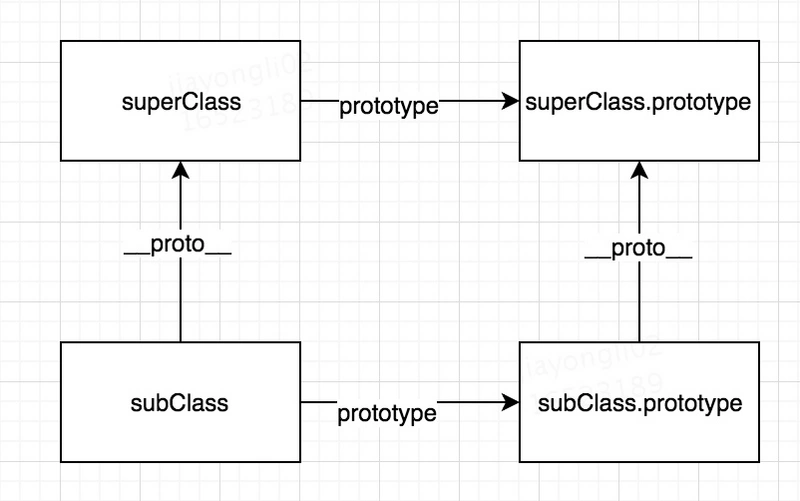ES6中class的实现原理
一、在ES6以前实现类和继承
实现类的代码如下:
function Person(name, age) {
this.name = name;
this.age = age;
}
Person.prototype.speakSomething = function () {
console.log("I can speek chinese");
};
实现继承的代码如下:一般使用原型链继承和call继承混合的形式
function Person(name) {
this.name = name;
}
Person.prototype.showName = function () {
return `名字是:${this.name}`;
};
function Student(name, skill) {
Person.call(this, name);//继承属性
this.skill = skill;
}
Student.prototype = new Person();//继承方法
二、ES6使用class定义类
class Parent {
constructor(name,age){
this.name = name;
this.age = age;
}
speakSomething(){
console.log("I can speek chinese");
}
}
经过babel转码之后
function _classCallCheck(instance, Constructor) {
if (!(instance instanceof Constructor)) {
throw new TypeError("Cannot call a class as a function");
}
}
var Parent = function () {
function Parent(name, age) {
_classCallCheck(this, Parent);
this.name = name;
this.age = age;
}
_createClass(Parent, [{
key: "speakSomething",
value: function speakSomething() {
console.log("I can speek chinese");
}
}]);
return Parent;
}();
可以看到ES6类的底层还是通过构造函数去创建的。
通过ES6创建的类,是不允许你直接调用的。在ES5中,构造函数是可以直接运行的,比如Parent()。但是在ES6就不行。我们可以看到转码的构造函数中有_classCallCheck(this, Parent)语句,这句话是防止你通过构造函数直接运行的。你直接在ES6运行Parent(),这是不允许的,ES6中抛出Class constructor Parent cannot be invoked without 'new'错误。转码后的会抛出Cannot call a class as a function.能够规范化类的使用方式。
转码中_createClass方法,它调用Object.defineProperty方法去给新创建的Parent添加各种属性。defineProperties(Constructor.prototype, protoProps)是给原型添加属性。如果你有静态属性,会直接添加到构造函数defineProperties(Constructor, staticProps)上。
三、ES6实现继承
我们给Parent添加静态属性,原型属性,内部属性。
class Parent {
static height = 12
constructor(name,age){
this.name = name;
this.age = age;
}
speakSomething(){
console.log("I can speek chinese");
}
}
Parent.prototype.color = 'yellow'
//定义子类,继承父类
class Child extends Parent {
static width = 18
constructor(name,age){
super(name,age);
}
coding(){
console.log("I can code JS");
}
}
经过babel转码之后
"use strict";
var _createClass = function () {
function defineProperties(target, props) {
for (var i = 0; i < props.length; i++) {
var descriptor = props[i];
descriptor.enumerable = descriptor.enumerable || false;
descriptor.configurable = true;
if ("value" in descriptor) descriptor.writable = true;
Object.defineProperty(target, descriptor.key, descriptor);
}
}
return function (Constructor, protoProps, staticProps) {
if (protoProps) defineProperties(Constructor.prototype, protoProps);
if (staticProps) defineProperties(Constructor, staticProps);
return Constructor;
};
}();
function _possibleConstructorReturn(self, call) {
if (!self) {
throw new ReferenceError("this hasn't been initialised - super() hasn't been called");
}
return call && (typeof call === "object" || typeof call === "function") ? call : self;
}
function _inherits(subClass, superClass) {
if (typeof superClass !== "function" && superClass !== null) {
throw new TypeError("Super expression must either be null or a function, not " + typeof superClass);
}
subClass.prototype = Object.create(superClass && superClass.prototype, {
constructor: {
value: subClass,
enumerable: false,
writable: true,
configurable: true
}
});
if (superClass) Object.setPrototypeOf ? Object.setPrototypeOf(subClass, superClass) : subClass.__proto__ = superClass;
}
function _classCallCheck(instance, Constructor) {
if (!(instance instanceof Constructor)) {
throw new TypeError("Cannot call a class as a function");
}
}
var Parent = function () {
function Parent(name, age) {
_classCallCheck(this, Parent);
this.name = name;
this.age = age;
}
_createClass(Parent, [{
key: "speakSomething",
value: function speakSomething() {
console.log("I can speek chinese");
}
}]);
return Parent;
}();
Parent.height = 12;
Parent.prototype.color = 'yellow';
//定义子类,继承父类
var Child = function (_Parent) {
_inherits(Child, _Parent);
function Child(name, age) {
_classCallCheck(this, Child);
return _possibleConstructorReturn(this, (Child.__proto__ || Object.getPrototypeOf(Child)).call(this, name, age));
}
_createClass(Child, [{
key: "coding",
value: function coding() {
console.log("I can code JS");
}
}]);
return Child;
}(Parent);
Child.width = 18;
构造类的方法都没变,只是添加了_inherits核心方法来实现继承。具体步骤如下:
首先是判断父类的类型,然后:
subClass.prototype = Object.create(superClass && superClass.prototype, {
constructor: {
value: subClass,
enumerable: false,
writable: true,
configurable: true
}
});
这段代码翻译下来就是
function F(){}
F.prototype = superClass.prototype
subClass.prototype = new F()
subClass.prototype.constructor = subClass
接下来就是subClass.__proto__ = superClass
_inherits核心思想就是下面两句:
subClass.prototype.__proto__ = superClass.prototype
subClass.__proto__ = superClass
如下图所示:

首先 subClass.prototype.__proto__ = superClass.prototype保证了子类的实例instanceof父类是true,子类的实例可以访问到父类的属性,包括内部属性,以及原型属性。
其次,subClass.__proto__ = superClass,保证了静态属性也能访问到,也就是这个例子中的Child.height。
ES6中class的实现原理的更多相关文章
- 前端知识体系:JavaScript基础-原型和原型链-理解 es6 中class构造以及继承的底层实现原理
理解 es6 中class构造以及继承的底层实现原理 原文链接:https://blog.csdn.net/qq_34149805/article/details/86105123 1.ES6 cla ...
- ES6中的Class
对于javascript来说,类是一种可选(而不是必须)的设计模式,而且在JavaScript这样的[[Prototype]] 语言中实现类是很蹩脚的. 这种蹩脚的感觉不只是来源于语法,虽然语法是很重 ...
- ES5和ES6中对于继承的实现方法
在ES5继承的实现非常有趣的,由于没有传统面向对象类的概念,Javascript利用原型链的特性来实现继承,这其中有很多的属性指向和需要注意的地方. 原型链的特点和实现已经在之前的一篇整理说过了,就是 ...
- ES6中的元编程-Proxy & Reflect
前言 ES6已经出来好久了,但是工作中比较常用的只有let const声明,通过箭头函数改this指向,使用promise + async 解决异步编程,还有些数据类型方法...所以单独写一篇文章学习 ...
- ES6中的类继承和ES5中的继承模式详解
1.ES5中的继承模式 我们先看ES5中的继承. 既然要实现继承,首先我们得要有一个父类. Animal.prototype.eat = function(food) { console.log(th ...
- es6中的类及es5类的实现
目录 类的特点 类的特点 1.类只能通过new得到 在es6中类的使用只能是通过new,如果你将它作为一个函数执行,将会报错. //es6的写法 class Child { constructor() ...
- ES6中的迭代器、Generator函数以及Generator函数的异步操作
最近在写RN相关的东西,其中涉及到了redux-saga ,saga的实现原理就是ES6中的Generator函数,而Generator函数又和迭代器有着密不可分的关系.所以本篇博客先学习总结了ite ...
- 大厂HR面试必备ES6中的深入浅出面试题知识点
ESMAScript6简介,ES6是JavaScript语言的下一代标准,目的是让JavaScript语言可以写复杂的大型应用程序,成为企业级语言.那么ECMAScript和JavaScript的关系 ...
- 如何让 node 运行 es6 模块文件,及其原理
如何让 node 运行 es6 模块文件,及其原理 最新版的 node 支持最新版 ECMAScript 几乎所有特性,但有一个特性却一直到现在都还没有支持,那就是从 ES2015 开始定义的模块化机 ...
随机推荐
- [BZOJ3796]Mushroom追妹纸:后缀自动机+KMP
分析 这道题有个\(O(n)\)的后缀自动机做法,感觉很好理解就在这说一下. 先对\(s1\)和\(s2\)求最长公共子串,对于\(s2\)的每一个下标\(i\),求一个\(f[i]\)表示以\(s2 ...
- mysql 5.7 Could not load driverClass com.mysql.cj.jdbc.Driver
参考: http://www.manongjc.com/article/24424.html https://blog.csdn.net/kingscoming/article/details/788 ...
- Hibernate一级缓存之懒加载问题
Hibernate的懒加载: 当用到数据的时候才向数据库查询,这就是hibernate的懒加载特性. 目的,为提高程序执行效率. 查询操作:get()方法/load()方法 (1)get()方法,及时 ...
- 转 实例具体解释DJANGO的 SELECT_RELATED 和 PREFETCH_RELATED 函数对 QUERYSET 查询的优化(二)
https://blog.csdn.net/cugbabybear/article/details/38342793 这是本系列的第二篇,内容是 prefetch_related() 函数的用途.实现 ...
- OpenCV学习笔记(1)
一.读入图像 使用cv2.imread()读入图像,图像应该在此程序的工作路径,第二个参数是告诉函数应该如何读取这幅图片 cv2.IMREAD_COLOR:读入一副彩色图像.图像的透明度会被忽略,这是 ...
- Navicat Premium Mac 12 破解方法-亲测成功
参照这2篇文档,破解成功了.操作步骤写的很清楚,不再缀述,只记录一下自己破解过程中,认为要注意的点.以免以后再多花时间熟悉重新熟悉操作步骤 Mac安装Navicat(破解版) Navicat Prem ...
- ftp4j揭示java.net.SocketException: Connection reset的解决
ftp4j提示java.net.SocketException: Connection reset的解决系统的自动更新FTP服务器,其他计算机连接都没有问题,包括xp.server2008.win7. ...
- linux 学习笔记一
Linux 学习笔记一 计算机 主要分为五个部分:控制器,运算器,存储器,输入设备,输出设备. 操作系统 操作系统就是针对硬件编写的程序,同时提供硬件接口调用的接口.操作系统需要处理如管理与配置内存. ...
- HTML——<body> 计算机代码 【头部在“网站开发”中】
HTML属性 完整的属性列表 在引用属性值的时候,如果某些属性本身就有双引号——name= 'John "ShotGun" Nelson'
- Django-DRF组件学习-路由学习
1.路由router 对于视图集ViewSet,我们除了可以自己手动指明请求方式与动作action之间的对应关系外,还可以使用Routers来帮助我们快速实现路由信息. REST framework提 ...
